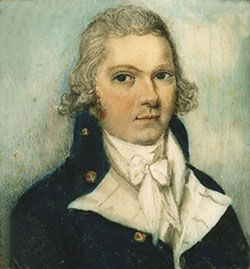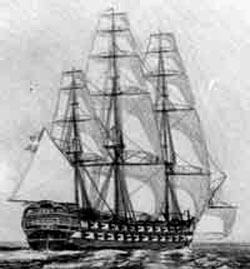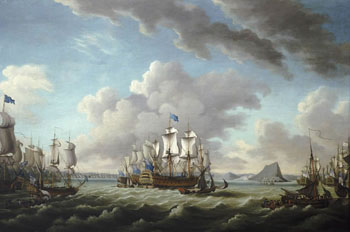| |
| |
|
Captain Henry
Duncan RN ²1735
- 1814 |
|
'From the Journals of
Henry Duncan' |
|
by J.K. Laughton |
|
|
|
Introduction
Of Henry Duncan, the writer
of the following journals little is known beyond the incidents of his
professional career. He was born in Dundee Scotland 24th Jan.
²1735 to
Alexander Duncan, Town Clerk of Dundee and Isobel Crawford. His great,
great, grandfather was Alexander Duncan of Seaside & Lundie 1652 - 1696,
Provost of Dundee, making Henry a second cousin to
Admiral Adam Duncan, Viscount Camperdown.
He began his sea life in
the merchant service - possibly in that of the East India Company, with many
others of his name - but entered the Navy on 10th May, 1755, as an able
seaman on board the Nassau, commanded by Captain George Cokburne, in the
Western Squadron. A few months later Cokburne was suspended by James Sayer,
who early in the following year rated Duncan a midshipman. In the summer of
1756 the Nassau went out to the Mediterranean, one of a small squadron sent
to reinforce Admiral Byng, whom it did not meet till his return to
Gibraltar after the action off Minorca. In 1757 the
Nassau, |
| |
 |
| |
Captain Henry Duncan Royal
Navy |
|
|
still commanded by Sayer,
was one of the fleet with Vice-Admiral Holburne at Halifax and off
Louisbourg. In the following February Duncan joined the Newark,
commanded by William Holburne, the admiral's brother, which in the summer of
1758 was one of the fleet off Brest under Lord Anson. On 3rd January, 1759,
he passed his examination for lieutenant; and on 23rd March, the ship being
at Plymouth, Holbourne, who was senior officer there, gave him an acting
order as third lieutenant of the America, then on the point of sailing for
the Mediterranean. At Gibraltar she found the squadron under Vice-Admiral
Brodrick, who promptly relieved Duncan by promoting one of his own
midshipmen into the vacancy; and - as a small compensation - took Duncan
into his flagship, the 90-gun ship Prince, as a midshipman. In the Prince,
Duncan remained during the summer, and in her witnessed, rather than took
part in, the celebrated action of 18th August; though on the 19th the ship
rendered useful service in securing the prizes. On the 20th, Duncan was
transferred to Boscawen's flagship, the Namur, where he was rated a.b.; but
on her return to England he was promoted - 21st September, 1759- to be
lieutenant of the Barfleur, employed during the following year as a
guardship. |
 |
|
|
HMS Nassau |
|
|
In December, 1760, he was
appointed to the Hampton Court, and took part, in the spring of 1761, in the
reduction of Belle Isle. As winter approached he seems to have got leave,
sufficient at any rate to go to Dartmouth, where, in St. Saviour's Church,
on 27th November, he married Mary French (1). But, still in the Hampton
Court, he went out to the West Indies in 1762, had his share in the capture
of Havana, where he served, apparently, in the batteries on shore, and in
October was moved to the Temeraire, one of the ships which remained at
Jamaica with Keppel. At the peace the Temeraire was paid off, and Duncan
spent the next six years on shore on half-pay. At this time he seems to have
settled down at Dartmouth. That his married life was happy appears from
numerous incidental remarks in the journal. Two children are registered as
having been born at this time - Isabella, baptized 23rd August, 1764, and
Arthur French, baptized 9th February, 1769,(1) Another son, Henry, whose
name suggests that he was the elder, was probably born away from home. He
entered the Navy as his father's servant in 1781; and in 1802 was commander
of the Scout, when she was lost, with all on board, off the coast
of Newfoundland. |
|
His death was not yet known
on 29th April, 1802, when he was included in the large peace promotion to
post rank.
On 26th May, 1768, Duncan was promoted to commander, and in September, 1769,
he was appointed to the Wasp, sloop, which he commanded on the home station
for the next three years. Then followed another spell of half-pay, till on
7th February, 1776, he was promoted to the rank of captain. One important
influence his marriage had on his career in the service. It seems probable
that Miss French had brought him an easy fortune, so as to make it
unnecessary for him to be at sea in time of peace; but it may be taken as
certain that she had him such interest as insured him a choice of service
when the proper time arrived. From 1757 and on till 1782, Lord Howe was
member of Parliament for Dartmouth, and the influence of Duncan's
connections had to be recognised. When, in January, 1776, Howe was appointed
to the command in North America, it had probably been long agreed that
Duncan should go with him as flag captain; so he was posted, as has been
said, and appointed to the Eagle. His career for the next six or seven years
is fully related in the following pages, which give an account of the work
of the Navy during the very troublesome operations of
1776-8, with a wealth of |
|
detail which is not to be
found elsewhere. This is the really important part of the journals, though
the cruise of the Medea in 1781 is interesting; and Duncan's position as
flag captain in 1782 gives a peculiar value to his account of the relief of
Gibraltar and the encounter off Cape Spartel. On the 5th December, 1782,
Duncan was discharged from the Victory - the note 'allowed six weeks" being
added to the D. in the pay-book. It is the earliest instance that has come
to my knowledge of full-pay leave granted on being discharged from a ship.
On the 17th January, 1783, he was put on the half-pay list. Two months
later' Howe being then first lord of the Admiralty, he was appointed
commissioner at Halifax, where he went with his wife and family in the
following August. On the 22nd October he wrote, notifying his arrival, and
adding that, not finding any flag or senior |
| |
 |
| |
Relief of Gibraltar by
Earl Howe, 11 October 1782 |
|
|
captain there, he had taken
charge. This was not unusual, and was indeed very commonly ordered in set
terms in the appointment as resident commissioner; though - as every one
will recollect - it involved an assumption of authority which gave such
great offence to Nelson at Antigua.
At Halifax Duncan remained
till 1799, when he returned to England, to be appointed in the following
year commissioner at Sheerness, and in January, 1801, deputy-comptroller of
the Navy. This office he held till 1806, when he retired and was put on the
list of superannuated captains, with a pension of 900l. a year. For the next
eight years he resided at Dartmouth, where he owned a convenient residence,
with stable, coach-house, &c., known as Mount Pleasant. There he died on the
7th October, 1814. His widow, who survived till the 25th September, 1823,
was allowed a pension of 300l, a year; besides which she inherited, under
her husband's will, Mount Pleasant and all belonging to it, together with
money and an estate in Newfoundland. The will also mentions his daughter
Isabella, Mrs. Troysdon, and her children; the widow of his son, the late
Captain Henry Duncan; his sister, Mrs. Stevenson, and her son, Captain
Stevenson, a captain of 1812. The name Arthur French Duncan does not appear
in the will; it may be presumed that he died young, or, at any rate,
unmarried.
The journals here printed are in five note-books (6"x4") closely filled with
small and now much-faded writing in Duncan's hand. With some few exceptions,
which he himself called attention to, the entries seem to have been written
from day to day. The identity of the handwriting being clearly established
by comparison with Duncan's official letters in the Public Record Office,
the history of the little books is not of so much importance as it would
otherwise be. This is fortunate, for they have no 'pedigree'. At the sale of
the effects of Commander Thomas Cull, who died at Poole in 1886, they were
bought by the present owner, Mr. Joseph Hall, of Hove, from whom the Society
has now received permission to print them. How they came into Captain Cull's
possession is not known. There may have been some family connection, or he
may have bought them. But the main point is that, both by the intrinsic
evidence and the identity of the handwriting, the genuineness of the
journals may be considered absolutely certain. The maps are take from those
in Jeffery's American Atlas, 1778.
(1) For this information, and for much trouble taken in searching the
Dartmouth register, I am indebted to the kindly assistance of Mr. Hamilton
Williams, of the Britannia.
²
Footnote
The Register of Baptisms for the Parish of Dundee records Henry Duncan's
baptism thus :-
1739 Jan 24 born, Jan 27
baptised Name :- Henry Parents :- Mr Alexr Duncan, clerk, Isobel Crawford
Witnesses :-In commemoration of Henry Crawford late of Monorgan,
grandfather, Henry Crawford of Monorgan, uncle
Alexander Duncan's baptism can be found in the Register of Baptisms for
Edinburgh
10 October 1709 George Duncan, writer to the signet, and Hellen Balfour, his
spouse, A.S.N. [a son named] Alexander. Witnesses John Duncan laite Baillie,
James Balfour merc[han]t and Alexander Montieth chyrurgeon apothacary was
born this day.
George Duncan's baptism is at Dundee, and thus establishes Alexander Duncan
of Lundie as Henry Duncan's great grandfather
1683, Mar 21 Wodnsday Name :- George Parents :- Alexr Duncan of Lundie, Anna
Drummond Witnesses :- George Browne, late Provost, Adam Drummond of Megginch
George Duncan's brother, Alexander Duncan, married Isobel Murray, the eldest
daughter of Sir Patrick Murray of Ochtertyre. Alexander Duncan, the son of
Alexander Duncan and Isobel Murray married Helen Haldane, and with Adam
Duncan being issue of this marriage the relationship between Adam Duncan and
Henry Duncan is confirmed as that of second cousins. |
| |
Acknowledgements:
© Copyright The Naval
Miscellany, Vol. I; Journals of Henry Duncan, Captain, Royal Navy 1776-1782,
J.K. Laughton some parts by John A. Duncan of Sketraw, FSA Scot.
. All rights reserved.
Sources;
Relief of Gibraltar by
Earl Howe, 11 October 1782 by Artist: Richard Paton, Crown Copyright ©
National Maritime Museum; Ship of the line HMS NASSAU (Formerly the Danish
ship HOLSTEEN). Drawing from the archives of the Royal Danish Naval Museum;
image of Captain Henry Duncan, © Royal Museum of Scotland.
Further information from
the research of Daryl Coup BSc MSc (Physics) BA (CompSci) New Zealand |
|
|
|



